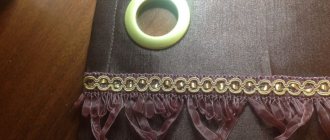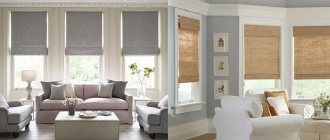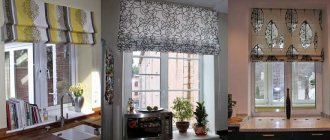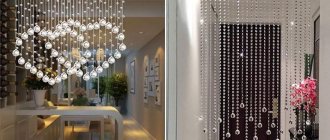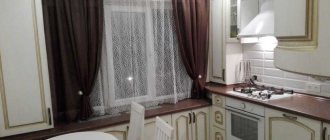Beautiful curtains for the kitchen, photo
Before settling on any specific curtain model, you need to consider the following factors:
- interior design of the kitchen so that the product successfully complements the interior.
- amount of sunlight. If the window is shaded by trees, the model is chosen in light colors, preferably tulle or organza.
- The location of the sink under the window requires short curtains.
The main thing in choosing curtains for the kitchen is convenience and practicality.
For small rooms, it is better to sew short curtains, up to the window sill or the middle of the window. This is especially true in cases where the window sill serves as a work area. It is better to opt for models adjacent to the glass: Roman, roller or blinds. Roman curtains
Curtains-blinds The classic model of two curtains on the sides and a curtain will look good on a large window. Eyelets, loops and bows are used to attach curtains.
The classic model is slightly modified for a small space, for example, one curtain is attached or two crossed panels are selected for the cornice.
The unity of colors of curtains and the decoration of chairs, tablecloths or pillows in the corner will bring originality to the interior.
A novelty is the “cafe style” style of curtains, when a crossbar for two short curtains is attached to the middle of the window, and the top of the window is decorated with a lambrequin.
Window decoration in Provence style is a combination of harmony and practicality.
An interesting idea for curtains with a slit, so that when the door to the balcony is opened, the main decor remains intact. And the cornices are placed asymmetrically to complement the interior design.
Ethnic style is based on a simple cut.
It is enough to cut out rectangular panels and a simple lambrequin in the form of a rectangle to fit the window size. Seam allowances are provided on the parts. For bay windows, an acceptable rule is: for small windows, Roman blinds are suitable; for an opening along the entire length of the wall, curtains are suitable.
Curtains in the English style will bring both aristocracy and severity to the interior. They consist of a rectangular panel in which special cords form wavy folds in several places. Such models are not sewn below the window sill.
Calculation of the quantity of materials
After measuring the window, we will calculate the amount of fabric; we need to add an allowance for processing the side seams and bottom. When purchasing curtain tape, be sure to consult with the seller to determine how much fabric consumption will increase. The simplest braid tightens the material in half. The choice of braid depends on the model of curtains for the kitchen, the cornice, the method of fastening and the desire to sew it yourself.
The market offers a wide selection of all kinds of fabrics for curtains and accessories.
So, the length of the curtains plus ten centimeters for processing the bottom. The width is equal to the amount of braid, which, when assembled, is equal to the length of the cornice. The organza has a ready-made weight seam along the bottom; no additional processing is required.
Organza is perfect for sewing curtains for the kitchen
After purchasing textiles, be sure to iron them with steam to remove any existing creases. Natural fabrics may shrink, so add 10 centimeters when purchasing. The heating mode of the iron is selected in accordance with the composition of the fabric. Sewing curtains with your own hands will give you a lot of pleasure.
Depending on the composition of the fabric, you need to select an ironing mode
If you intend to sew curtains with your own hands, but you have little experience, then choose simple models for the kitchen that do not require patterns. The beauty of such curtains as in the photo depends only on the choice of fabric color. The textile design must fit harmoniously into the interior.
Beautiful fabric with a fashionable print will help make the simplest curtains the highlight of your interior.
How to sew a curtain for the kitchen with a lambrequin, patterns step by step with photos
Decorating windows with lambrequins will not only decorate the kitchen, but will also hide the cornice and fixtures from prying eyes. The product can be simple, soft, hard, combined and figured. To sew a lambrequin, rectangular or shaped panels are used, and they are decorated with bows, ribbons and fringe. Satin, silk, voile, polyester, linen and even velvet are suitable for lambrequins.
To get started, you need to do the following:
- remove window dimensions;
- decide on the model;
- make a sketch;
- determine how much the lambrequin should cover the window;
- cut out the pattern;
- start sewing.
For a cornice 180 cm long you need:
- two-color veil, for example, cream and white;
- 9 eyelets;
- bias satin trim.
Progress:
- A 45x404 cm rectangle is cut out of a cream voile. The sides and bottom are trimmed with bias tape. A trapezoid with an elongated angle, measuring 202x45x100 cm, is made of white material. Three edges, except the top, are also treated with trim.
- Two pieces folded together are connected at the top. The edges are overlocked and then folded and stitched.
- The lambrequin is turned out and smoothed. On top, 1 cm away from the top edge of the panel, make marks for the eyelets. Having folded the workpiece in half, mark the central fastening, and then mark the rest at a distance of 40 cm.
- Attach the lambrequin to the cornice with ties made from tape. It is threaded through the eyelets and knitted with loops to the cornice.
Step-by-step instructions for creating a pattern
Do-it-yourself kitchen curtains with patterns will be much more accurate and neatly made than curtains sewn “by eye.” First of all, you need to take measurements.
Do-it-yourself kitchen curtains with patterns will be much more accurate and neatly made than curtains sewn “by eye.”
Before sewing curtains for your kitchen, you need to do the following.
- Decide on the model of future curtains.
- Take accurate measurements of all necessary parameters (length, width, height). For classic curtains, measurements are more difficult - you need to take into account the width of the future cornice, the distance from the window to the ceiling, and the dimensions of the partitions (the distance from the window to the corner of the room).
- Find a suitable pattern or come up with your own.
After this, they move on to making patterns and sewing curtains.
- The pattern is transferred to thick paper (unnecessary wallpaper is good for this). It is important to keep the scale exactly.
- The pattern pieces are pinned to the fabric and traced with chalk or a washable marker on the fabric. At the same time, you must not forget to leave seam allowances (take into account the method of processing the edges).
- Parts (or part) of the future curtain are cut out. Before doing this, be sure to iron the fabric so that there are no distortions or folds.
- You can move on to sewing. In the process, you need to think about the most convenient way to attach curtains to the curtain rod. Whether you sew curtain tape to gather in folds, or whether the curtains will be held on hinges, depends on the general idea of the curtain and the interior in which it will be located.
- The edges need to be processed. If this is not an original design move, then the edges with protruding threads will look more than sloppy. The methods can also be different - a regular seam with a hem or a bias tape.
You may not get the perfect DIY kitchen curtains the first time. But there is no need to despair, as everything will come with experience.
You may not get the perfect DIY kitchen curtains the first time. But there is no need to despair, as everything will come with experience.
See also: Decorating curtains with your own hands, photo.
Arch curtains for the kitchen, patterns step by step with photos
Arched curtains are characterized by an arched shape and hanging edges. Such models are ideal for small spaces, especially in the case of a window sill-work area. Curtains are often used for classic and rustic styles. A curtain in the form of an arch should be draped, so translucent fabrics are used for it: tulle, organza, veil. For sewing, a material with a width of at least 100 cm is suitable, but the dimensions of the window are taken into account.
The color of the arched curtain can complement the shade of kitchen textiles.
Option No. 1 Classic arch
- To cut a semicircle, divide the width of the window by three. This will be the radius.
- The material is folded in half and a semicircle is cut out according to the pattern. Its edges are covered with braid.
- The length of the curtain is measured in two ways: the window height is multiplied by 2 + 2 r or the window height + hanger + 8 cm.
- Rectangles are cut on both sides of the canvas, the base of which is equal to 1/5 of the width of the window.
- Braid or adhesive tape is sewn on top.
Option No. 2 Curtain with a patterned bottom In this option, we’ll look at how to sew an arch to preserve the bottom tulle pattern. In such cases, a semicircle is made on top.
- First, measure the dimensions of the window and make a rectangular blank, not forgetting about the seam allowance.
- Fold the material in half and cut out an arch, leaving 50-60 cm on the sides. The semicircle should be smooth.
- The sides are hemmed, and the top is folded and covered with a tightening braid.
Option No. 3 Poplin curtain In this option, a semicircle is also made on top. In order for the curtain to have flowing flounces, the fabric for the arch is taken 2 times the width of the cornice. The rectangular fabric is folded together face to face. About 20 cm are left on the sides. 1/3 of the canvas is measured straight, and then 2/3 is connected to the sides at an angle.
You can fasten the arched curtain using tape, eyelets and loops.
Making Roman blinds
Making a Roman blind with your own hands is a little easier than a classic curtain. To create a pattern, only the dimensions of the window are taken into account, since this type of curtain is adjusted exactly to the window opening.
Making a Roman blind with your own hands is a little easier than a classic curtain.
You need to decide on the type of fastening. If the window sills in the house are wide, then the curtains are attached inside the window opening. If you choose the type of fastening outside the window, on the cornice, then you need to leave a small overlap, about 10 cm, outside the window.
You need to decide on the type of fastening.
To sew a Roman blind, you need:
- fabric and lining material;
- adhesive tape (length matches the width of the curtain);
- two plastic rings for each future drawstring.
- cord for lifting curtains;
- wooden plank and weighting material.
The sewing sequence is simple.
- On the wrong side of the line along which the fold will run, you need to mark the places of future folds and rings at an equal distance.
- Process the edges of future curtains.
- Attach the adhesive tape to the wooden plank (this can be done with a furniture stapler). The curtain will be held on it.
- Treat the top of the curtain and also attach Velcro tape to it.
- At the bottom of the curtain, make a fold for the weight bar.
- On the wrong side, sew the finishing border in the required places. You can place the base and weighting material in the resulting pockets.
- Sew on the rings.
- Using adhesive tape, attach the top of the curtain to the wooden beam.
- The part of the cord on which it will be held should be secured to the frame or near the window. Pull the cord through the rings, starting from the bottom. The lace needs to be secured to the first ring.
- Secure the resulting folds with tape.
Next, you can attach the wooden plank to the frame. If you untie the tape, the curtain will lower. It is necessary to ensure that the cords are tensioned equally everywhere. Behind the last ring you need to pull the ends of all the cords and tie them into a knot. The ends protruding from the knot are cut off. All that remains is to fix the cord around the mount on the window.
If you untie the tape, the curtain will go down
Despite the long description of the process, in practice making a Roman blind yourself is quite simple.
See alsoCorrect kitchen design 9 sq. m: what's the secret?
Curtains for the kitchen on a window with a door, options for modern curtains, patterns
Having a window with a door to the balcony in the kitchen is beneficial, but choosing a curtain for such a model is a little problematic. When choosing, you should take into account that the door will open repeatedly, and the owners will go out onto the balcony. For such windows, they try not to use bulky, heavy curtains and damaged materials. It is hardly possible to select ready-made models, because the windows in houses are non-standard. Here are three options with patterns that the housewife can sew on her own.
Roman curtain
Often, the kitchen door opens inward, so it is better to cover the multifunctional window with a Roman blind. It will fit tightly to the glass and will not interfere with walking.
Classic curtain with tieback
If desired, half of the window can be covered with a rectangular curtain reaching the floor, but it is secured at the edges with braid or chain. This model is suitable for large spaces.
Combined curtain made of tulle, which is complemented with swag.
Models for inexperienced dressmakers
- Arched curtain - to sew such a curtain, it is enough to have minimal sewing skills. You can sew it even without a pattern. The main thing is to take accurate measurements of the window and add about 10 cm more to the width (in order to get beautiful folds).
- Cafe curtains are curtains that are called “granny window”. One of the easiest curtains to create. These curtains are short and can be used as curtains for the kitchen with your own hands without a pattern. Often they do not need a curtain rod (you can use a simple cord).
- Curtains with ties. They usually consist of three parts of fabric, often the middle one is in a contrasting color with the sides. Sewing such curtains also requires a minimum of sewing and measuring skills.
- Austrian curtains. They can be sewn from different fabrics, but tulle ones are recommended for the kitchen. When sewing them, as when sewing Roman blinds, it is important to maintain a uniform distance between the tiebacks.
Thus, in all the variety of styles and types of curtains for the kitchen, it is important to decide and choose exactly the option that will look harmonious in your interior. The key here is the imagination and skillful hands of the hostess.
In all the variety of styles and types of curtains for the kitchen, it is important to decide and choose exactly the option that will look harmonious in your interior.
See alsoFeatures of surface finishing with decorative stone
Curtains for a small kitchen window, patterns, details with photos
The main requirement for curtains in a small kitchen is to visually expand the space. When choosing fabrics for small kitchens, preference is given to natural bases, because a stove is often placed next to the window. Designers choose lifting curtains: Austrian or roller blinds.
Australian curtains
Australian curtains are distinguished by their smooth fabric, with scallops formed at the bottom. Their height is adjustable. For sewing, taffeta, satin or micro-veil are used. The flounces are assembled using curtain braid and decorated with flowers and bows. For small spaces, opt for light colors.
The width of the material is determined by multiplying by two widths of the cornice. Then the canvas is divided into the number of folds required, the approximate distance between which is 30-60 cm.
Lush flounces on an arched curtain will bring coziness to a small space.
Progress:
Roll model
Roller blinds take up minimal space and do not overload the space. They are fixed with tapes and held on a rod, which serves as a weight. The curtain can be attached to the window itself or to the cornice.
Cutting fabric
No matter what we are talking about - sewing curtains for the kitchen or making a complex curtain composition - no one can avoid the work of cutting fabric. This stage at home is best done in a large room on the floor . Having positioned the piece of fabric in the desired direction, patterns (patterns) are laid out on it, previously cut to life-size from old newspapers, wallpaper, or any available material.
Patterns are used for applying and drawing life-size patterns directly on the canvas. It is important to remember to mark the margins that go into the seams and hems . And never forget the folk wisdom: “measure seven times...”.
So, patterns or patterns attached to the fabric are outlined with crayons, and it is recommended to highlight different design elements in different colors. Traces from tailor's chalk are easily removed, so the necessary informative marks are applied to the fabric during the cutting process, designed to facilitate the assembly stage of the product.
Finally, they begin to cut the fabric using sharp tailor's scissors. This is exactly what is called: “...cut once.” The finished parts are carefully folded, trying not to create unnecessary folds and wrinkles.
itself does not have to be performed immediately after cutting . The sewing stage requires careful preparation of the workplace and the tools used in the work. Especially if your technology involves visiting a workshop to install accessories.
Short tulle curtains for the kitchen, patterns, master class with photos
Short curtains not only protect the kitchen from sunlight, but also give the housewife less trouble with maintenance. They are less fire hazardous and do not interfere with the cooking process. Similar models are needed:
- for small spaces, because a tulle curtain adds lightness and increases the volume of the kitchen.
- does not interfere with free access to the window sill, even in the closed position.
- Suitable for windows with a door to the balcony.
If we talk about short curtains, there is no consensus on what exactly the length should be: reach the middle of the window, window sill, or a short lambrequin up to 50 cm wide.
Curtain with drawstring
This model is tightened diagonally with curtain tape and assembled on one side of the window.
Arched tulle curtain
Curtain with eyelets, master class with photo
The tulle curtain is attached to eyelets, creating beautiful wavy folds.
To sew it you need:
- the size of the tulle is equal to the width of the cornice multiplied by 2.5;
- finishing cuff fabric (width 25 cm);
- grommet tape;
- eyelets 8 pcs.
An approximate table of the number of hinges for a certain window width, as well as the approximate distance between the fasteners.
Detailed pattern
First, cut the tulle according to the pattern. To remove excess, just pull out the thread and cut along it. The side sections are closed. In the middle of the finishing cuff, chalk strokes are drawn along which the tape is laid. Using an ironing iron, glue it to the cuff, bend it and iron it again. In the middle, measure the seam allowance, which is also fixed with an iron. Using a machine, sew along the edges of the cuff, except for the bottom, and turn it inside out on the face. The resulting part is ironed.
Tulle is placed in the cuff, sewn and ironed. From the top edge of the cuff, leaving 4 cm, mark points for eyelets. Attach the fasteners and trace their outline. Cut along the border of the eyelet, leaving 2 mm more fabric.
One part of the eyelet is placed under the bottom and snapped on top. The curtain is ready, you can attach it to the cornice.
General rules for sewing curtains
To begin with, you should pay attention to simple models that will not require professional skill from you and long hours of torment at the sewing machine. Only after gaining initial experience will you be able to move forward in improving your handicraft. Key points before you start:
- Textile. The selection of options depends on the characteristics of the room. Remember that cooking takes place in the kitchen, so the risk of contamination is very high. It is better to buy a fabric that does not absorb odors and repels dirt. The fabric must first be washed and ironed, since during the first wash the new fabric may shrink, and the length cannot be corrected after cutting. In addition, high-quality ironing will help avoid folds and creases, which can affect the accuracy of the pattern.
Interesting! You can purchase fabrics for curtains, since their standard width is 2.8 meters, and in this case, when turning, the width becomes the height of your curtain, and the needlewoman may not process the top and bottom of the product.
- Calculation of the amount of fabric. For correct calculations, consider the length of the textile and the style. Measure the length from the cornice to the desired mark. To correctly calculate the required amount of fabric in width, measure the curtain rod from edge to edge. Be careful, count not from the opening itself, but from the cornice. Also consider the crease factor.
- Workplace. Set the machine to the desired mode, depending on the type of fabric. You will need a smooth and flat surface, preferably a table or floor, as well as pins, scissors, needles and special chalk for marking. Select a ready-made curtain pattern and begin the process.
- Lay out the material, pinning it to a flat surface. Make sure that the fabric does not move. Transfer the desired pattern, cut along the lines and only then remove the pins.
Curtains for the kitchen in Provence style, patterns with photos
Provence style exudes simplicity and comfort. Usually it included two rectangular panels on a drawstring with a “comb”. They are decorated with frills and picked up on the sides with ribbons and cords. Modern designs have added loops, lambrequins, bow fastenings and buttons to the rustic style. Two panels are mounted on the cornice or in the window opening.
Option No. 1 Curtain with lambrequin
The style is characterized by a texture with small bouquets of roses or lavender, which grow in the south of France.
Option No. 2 Olive ensemble
Sometimes the window opening is covered with a tulle panel and a wide lambrequin on top. The color of the material is chosen to be soft, usually olive or pastel. An example of an olive ensemble with colorful tulle.
Option No. 3 Traditional country
This model consists of traditional cafe curtains and an upper rectangular lambrequin. The shade of the curtains should match the tone of the home textiles. The pattern is given with varying degrees of completeness of the flounce.
Patterns for ethno style
Curtains in ethnic style, as a rule, have a distinctly simple cut. You can sew such curtains yourself without any problems. The patterns here are also elementary and are rectangular panels. A simple lambrequin, also in the form of a rectangle, is quite acceptable for them. You can make such a pattern yourself, based on the size of a particular window. For rectangular pieces, you only need to add allowances for seams and allowances for drapery (if any).
Ethnic style, as a rule, includes the simplest modifications of patterns for curtains
Curtains for the kitchen in a modern style, patterns with photos
Modern kitchen curtains are most often made in eco style using natural materials or in fusion style, when incompatible things are combined. Option No. 1 Italian classic The model of a simple curtain with an imperial one is successfully combined in an Italian curtain. Such models are draped with tiebacks. It can completely cover the window opening or be raised using a cord passed from the inside through a ring.
Option No. 2 Model “Blade of Grass” on rods The curtain option below is universal. It is suitable for both large and small spaces. It is easy to sew, because both parts are similar to each other, the only difference is their length. Curtains are attached directly to the window using iron rods.
The pattern is given for a window measuring 100x120 cm. The eyelets are located at a distance of 16 cm.
Option No. 3 A selection of modern curtains and tulle for the kitchen in 2018.
French curtains for the kitchen, patterns with photos
The French model of curtains is the most pompous. It gives airiness and sophistication. Light, flowing fabrics are used for tailoring, and they are decorated with fringe, ruffles and tassels. Typically, such models are framed with double-sided curtains.
The pattern is based on vertical guides into which the tightening tape is threaded.
Option No. 2 When two shades of fabrics are combined in one model.
Two sketch options for French curtains. One is decorated with flounces, the other is classic with tassels.
An example when flounces and tassels are combined on one curtain.
Curtain design for a small kitchen, curtain ideas with patterns
Flowing models in light shades visually increase the space. To expand the space, use classic or asymmetrical curtains.
It is better to avoid ruffles and flounces in small-sized kitchens.
You can transform your kitchen and adjust the room if the window is placed incorrectly using asymmetrical curtains.
Roman blinds adjacent to the window are an excellent choice for Khrushchev.
Curtain elements
The type of curtains that will bring coziness to the interior of a small-sized kitchen are arched models that are loved by many. Any type and color of fabric is suitable for sewing them.
Several options for patterns of kitchen arches.
Curtain design for a classic kitchen, patterns with photos
For classic interiors, choose curtains made from natural materials and stick to simple models. These can be curtains with eyelets, ties, Velcro and loops. A hinged model made of lightweight materials that opens up the window sill area.
Pattern for window size 150x140 cm.
For classics, lush lambrequins are also appropriate.
A bright set of classic curtains with eyelets with a Roman model.
The cornice is attached at a height of 250 cm from the floor, the pattern size is given for a window of 115x90 cm.
Types of curtains for the kitchen and features of their tailoring
There are several most common types of curtains for the kitchen, each of which has its own characteristics.
Roman curtains
They combine simplicity, functionality and elegance. Roman curtains in the interior look beautiful and neat. They do not require special care, and to sew them you will need to purchase very little fabric. The only thing you need is to install a special type of cornice, mounted on the ceiling or in the upper part of the plastic window frame.
Roman blinds - beautiful and practical
The main problem that everyone who wants to sew Roman blinds faces is the correct determination of the width of the fold. Correct calculations can be made based on the height of the window and the number of folds expected. To sew curtains for the kitchen, you need to follow these steps:
- Lay the fabric out on a flat surface and make markings from the inside out where there will be lines of folds, hems and places where the rings are attached. The lines must run parallel;
- fold the bottom and sides. When turning up the bottom edge, it is necessary to provide a drawstring where a weighting agent (plastic, metal or wooden pin) will be placed, which will help the curtain to lie evenly. There is no need to sew up the drawstring - the weights will have to be removed with each wash;
- trim the top of the curtain, sew Velcro to it;
- sew a border from the inside along the marked fold lines;
- sew the rings according to the markings made;
- fix the curtain on the curtain rod and thread the cords through the rings.
Curtains in Provence style
The fashionable Provence interior style will make the kitchen more comfortable. The curtains are no longer than the window sill and have eyelets and tiebacks.
Cozy kitchen in Provence style
To sew curtains for the kitchen in this style, you must adhere to a number of rules:
- choose fabric in pastel colors, maybe even slightly faded;
- if a pattern is expected, it could be a stripe, a checkered pattern or flowers (as well as the currently popular cockerels);
- the fabric should be weightless, and the cut should be simple, without unnecessary ornateness.
Curtains with eyelets
Eyelets are round holes specially edged with plastic or metal in the upper part of the curtain. It is through them that it is strung onto the cornice. To sew kitchen curtains with eyelets with your own hands, you should correctly calculate the distance between the eyelets and remember that there should always be a pair of them.
Curtains with eyelets do not require additional fasteners
The distance depends on the size of the desired folds. For raised folds it is 20-22 cm, for soft folds - up to 15 cm.
It is important to determine the indentation from the top edge, which depends on how dense the curtain material is.
Having made notes for installing the rings, carefully cut out the roundness. The eyelets installed in these rounds on both sides are latched by hand or pressed with a press.
Curtains with loops
Fabrics made from natural materials are recommended as materials for this type of curtain. They will look most appropriate in kitchens with a simple interior. Their advantage is that there is no need to purchase additional fasteners. Additionally, you can decorate with ruffles, bows, frills - whatever your imagination suggests.
Curtains with loops - decorating a simple kitchen interior
To sew these curtains for the kitchen, you need:
- cut two panels of the same length from the main type of fabric;
- cut other details for decoration from an additional type of fabric. The lining is not always needed;
- It is imperative to process the side seams to prevent them from unraveling;
- then we sew the elements of the lower trim in the same way as pockets are sewn, then sew them to the main panel;
- fold the loops in half, sew them inside out, and then turn them inside out;
- Carefully smooth out the loops (the seam should be located in the central part), remove all threads and irregularities;
- baste the loops to the wrong side of the main panel;
- sew tiebacks. The fabric must be folded in half, sewn, then turned inside out and smoothed, making sure that the seam is in the center of the part.
Lambrequin curtains
Lambrequin curtains will create a festive atmosphere in the kitchen
Lambrequin is a fashionable modern accent in curtain design. Sewing beautiful lambrequin curtains is quite simple, and their elegant appearance will decorate any room:
- First you need to measure the width and height of the fabric. The width will coincide with the width of the window opening, and the length will be 0.6 m. The fabric can be made from natural fibers, mixed or synthetic;
- prepare a narrow satin ribbon and threads - their color should match the color of the main fabric;
- the fabric is smoothed, and its edges are folded and stitched;
- The top part of the fabric is folded to the thickness of the cornice. It needs to be swept and then stitched;
- the side seams are slightly gathered with thread (5-6 stitches);
- the curtain is hung on the cornice. The prepared satin ribbon is cut into 2 strips of 1.0 m each. The ribbons are thrown over the cornice and pulled together, which allows folds to be formed;
- The edges of the ribbons are tied with bows.
Knitted curtains
Crocheted curtains are suitable for several types of interiors
They will fit perfectly into several interior styles - country, rustic, Provence, shabby chic. Therefore, if you know how to crochet, you can knit curtains with your own hands. Threads can be white, pink, lilac, olive, blue, cream, pearl, milky. The main rule is muted, not bright colors. The patterns should be large and depict birds, butterflies, flowers and other plant and animal patterns. The combination of a knitted lambrequin and tulle looks original.
Austrian curtains
This type of curtains combines the advantages of French and Roman curtains. Such curtains are more appropriate in a bedroom or living room, but if you want to decorate the kitchen interior with them and are not afraid of the difficulties of caring for them, why not. The main thing when sewing these kitchen curtains is to calculate the required amount of material and not use too much. The wider the curtain folds, the more airy the entire product. The optimal length is up to the window sill.
To sew them you need:
- textile;
- braid;
- decorative elements (lace, fringe, braid).
Austrian curtains combine the best features of Roman and French models
To understand how to sew a curtain for the kitchen with your own hands in the Austrian style, you need to know that to determine the height of the product, measure the distance from the cornice to the window sill, and then add a little more depending on how splendid the festoons are supposed to be. For a discreet option, the length should be multiplied by 1.5, and for a more festive option - by 2.
Decorative elements are sewn at the bottom of the curtain.
Then the most important work begins - sewing on the braid. For a small product, it is enough to sew it along the side edges and in the center. The top part of the curtain is always flat, so the braid is sewn from the bottom to the middle of the product.
Then the braid cords are carefully tightened, forming beautiful folds. The ends of the cords can be tied together or neatly hidden. The second option is suitable for those who intend to periodically collect and dissolve festoons.
Curtains for the kitchen will become a stylish accent in its interior
Curtains for the kitchen on one side, patterns with photos
One-sided models allow the housewife to fully carry out housework, giving access to the window sill. Such models are used for windows with a door or when the frame is located in a non-standard opening.
The one-sided canvas successfully hides the flaws of the room.
Curtain with grommets, hung without a cornice.
One-sided curtain with frills, tied with a bow.
Corner curtain
A practical curtain with an angle is often used in design solutions when it is necessary to enhance the window sill.
Curtains for the kitchen, two windows, patterns with photos
Double curtains are often found in corner kitchens. They are decorated in the same style, for example a combination of tulle and classic curtains.
Pattern for a window measuring 115x90 cm, height from the cornice 250 cm.
When two windows are placed close to each other, they are designed as one whole. One of the best options for decorating double windows is roller blinds.
Airy French curtains are suitable for different types of windows.
Curtains for the kitchen from a voile, photo
Because of its delicacy and lightness, voile is often used for kitchen curtains. It transmits light well and is quite “obedient”.
The fabric does not overload the interior, but looks very elegant. A variant of two triangles that overlap each other.
The fabric for sewing must be without front and back sides.
Curtains for the kitchen made of organza, photo
Organza is a fairly popular material for sewing kitchen curtains. It varies in degree of transparency, color range, dullness and pattern. Organza is considered a capricious material, since any irregularities and flaws are visible on it.
For safety reasons, a curtain made of twisted silk fibers should not be placed near the stove.
Lightweight classic organza curtains with tiebacks.
Roller blinds can also be made from organza.
Organza curtain option with embroidery for a large window.
DIY curtains for the kitchen step by step
You can quickly make stylish Roman blinds for the kitchen yourself from old blinds. All you have to do is prepare:
- textile;
- spider web ribbon;
- special glue for fabric;
- blinds.
Blinds are selected according to the size of the window. Remove the cord that is responsible for turning the slats. But the one that lifts the mechanism is preserved.
At a distance of 25 cm, leave one strip at a time, and remove the rest by removing the lower caps with a knife.
Cut the fabric to the size of the blinds, leaving 5 cm around the perimeter for hems. The fabric is folded and ironed.
The hems are glued to the fabric with a “web”. The base is applied to the cornice and the distance of the left plates is marked on it with a pencil.
The front side of the device is coated with glue, and then the fabric is pressed tightly against it. It is desirable that the material protrudes slightly beyond the top edge. The bottom bar is wrapped in fabric and fixed with glue.
The curtain is left to dry and then mounted to the frame using standard blind mounts.
Curtain open
Closed window option.
It is up to the housewife to decide which curtain option to choose for her kitchen. The main thing is to take into account all the wishes, the interior of the kitchen and the location of the window.
Patterns for Roman style
Sewing these curtains is also easy even for sewing beginners. Roman blinds resemble blinds. They look good in a variety of interiors, ranging from minimalism to modern. The peculiarity of such curtains is that they are assembled vertically and not horizontally. Therefore, the curtain pattern is supplemented with a wooden strip - it will make the structure heavier and give the curtains rigidity.
The pattern itself is a simple rectangular panel. Its length in height should be the size of the window opening in height plus seam allowance.




